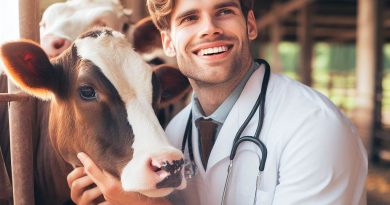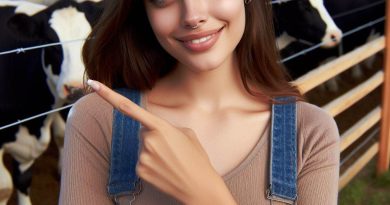Breeding Livestock: Basics for Farm Success
Last Updated on November 27, 2023
Introduction
Attention grabber
Breeding livestock is a vital aspect of farm success, ensuring high-quality animals and profitable results.
Background information on breeding livestock
Breeding livestock involves selectively mating animals to improve desirable traits and genetics.
Thesis statement introducing the importance of breeding for farm success
Effective breeding practices are crucial for farm success as they lead to improved productivity, profitability, and sustainability.
Understanding the Breeding Process
Definition of breeding
Breeding refers to the purposeful mating of animals to produce offspring with desired traits.
Different methods of breeding
- Natural breeding:
Natural breeding involves allowing animals to mate naturally without human intervention. - Artificial insemination:
In artificial insemination, semen from a male animal is collected and manually inserted into a female’s reproductive tract.
Explanation of the role of genetics in breeding
Genetics plays a crucial role in breeding as it determines the inheritance of traits from parents to offspring.
Importance of selecting high-quality breeding stock
Selecting high-quality breeding stock is essential for producing healthy and productive offspring.
Good breeding stock ensures the transmission of desirable traits, such as disease resistance and high productivity.
Breeding livestock is a fundamental aspect of successful farming.
It involves carefully selecting animals with desirable traits and using specific methods to ensure the production of high-quality offspring.
Understanding the breeding process is crucial for farmers who want to achieve desired outcomes and improve their livestock’s genetics.
Definition of breeding
Breeding is the deliberate mating of animals to produce offspring with desired characteristics.
It is a purposeful and controlled process that allows farmers to shape the future characteristics of their livestock.
By selecting animals with specific traits, farmers can enhance productivity, adaptability, and other desirable qualities within their herds.
Different methods of breeding
- Natural breeding:
Natural breeding occurs when animals mate without any human intervention. In this method, the male and female livestock are allowed to interact and mate naturally.
Natural breeding is suitable for farmers looking to maintain the natural genetic diversity of their herds. - Artificial insemination:
Artificial insemination (AI) is a more controlled breeding method. It involves collecting semen from a male animal and manually introducing it into the reproductive tract of a female.
AI offers several advantages, including the ability to utilize superior genetics from a distance and reduce the risk of transmitting diseases through natural mating.
Explanation of the role of genetics in breeding
Genetics plays a pivotal role in the breeding process. It determines the inheritance of traits from parents to offspring.
By selectively breeding animals with desired traits, farmers can enhance the overall quality of their herd.
Traits such as productivity, fertility, disease resistance, and conformation can be improved through careful breeding decisions.
Understanding the principles of genetics helps farmers make informed choices and achieve their breeding goals effectively.
Importance of selecting high-quality breeding stock
Selecting high-quality breeding stock is crucial for long-term farming success. Quality breeding stock ensures the transmission of desirable traits to future generations.
Farmers should prioritize animals with superior genetics, as they are more likely to produce offspring with similar advantageous traits.
High-quality breeding stock also contributes to the overall health and productivity of the herd.
Regular evaluation, such as assessing physical traits, performance records, and genetic testing, helps in selecting the best animals for breeding purposes.
In short, understanding the breeding process is essential for farmers aiming to enhance their livestock’s genetics.
By defining breeding, exploring different breeding methods, considering the role of genetics, and prioritizing high-quality breeding stock, farmers can ensure optimal results.
Breeding livestock with purpose and knowledge leads to the production of healthier and more productive offspring, ultimately contributing to the success and sustainability of the farm.
Read: Optimizing Feed for Livestock: Expert Advice
Preparing for Breeding
Assessing the health and fertility of breeding animals
- Schedule a thorough veterinary examination to assess the overall health of the breeding animals.
- Conduct fertility tests to ensure that the animals have the ability to reproduce successfully.
- Check for any genetic disorders or abnormalities that may affect the breeding process.
- Assess the animals’ temperament and behavior to ensure that they are suitable for breeding.
Implementing proper nutrition and care
- Provide a well-balanced diet that meets the specific nutritional needs of breeding animals.
- Incorporate supplements if necessary to enhance reproductive health and fertility.
- Ensure access to clean and fresh water at all times.
- Maintain appropriate body condition scores to optimize breeding potential.
- Regularly groom and provide necessary vaccinations and deworming to prevent diseases.
Ensuring a suitable environment for breeding
- Design and maintain comfortable and spacious housing facilities for breeding animals.
- Provide adequate ventilation to minimize the risk of respiratory infections.
- Control temperature and humidity levels to create an optimal breeding environment.
- Implement effective manure management practices to prevent the spread of diseases.
Developing a breeding plan based on farm goals and market demands
- Define the breeding objectives, such as improving specific traits or increasing flock/herd size.
- Consider market demands and consumer preferences when selecting breeding animals.
- Determine the appropriate breeding methods, such as natural mating or artificial insemination.
- Establish a breeding schedule that aligns with the reproductive cycles of the animals.
- Monitor and evaluate the progress of the breeding plan regularly to make necessary adjustments.
Preparing for breeding is crucial for farm success:
- Regular veterinary examinations assess overall health.
- Fertility tests confirm reproductive capability.
- Proper nutrition and care maximize breeding potential.
Ensure a suitable environment:
- Comfortable housing facilities for natural mating behaviors.
- Adequate ventilation to minimize respiratory infections.
- Controlled temperature and humidity for optimal reproduction.
- Effective manure management practices for a healthy breeding environment.
Develop a breeding plan:
- Define breeding objectives based on farm goals and market demands.
- Choose suitable breeding animals.
- Select appropriate breeding methods (natural mating or artificial insemination).
- Establish a breeding schedule aligned with reproductive cycles.
- Monitor and evaluate the plan for continuous improvement.
By prioritizing health, fertility, nutrition, care, environment, and a well-defined breeding plan, farmers increase breeding success.

Managing the Breeding Process
A successful breeding process is crucial for farm success. Here are some key steps to effectively manage the breeding process:
Tracking estrus cycles in females
- Observe behavioral changes: Pay attention to signs of heat in female livestock, such as mounting behavior and increased vocalization.
- Physical indicators: Look for physical signs like a swollen vulva, clear or bloody discharge, and increased activity.
- Keep records: Maintain accurate records of breeding dates, estrus symptoms, and any other relevant observations to track cycles.
- Use technology: Explore advanced tools like estrus detection patches or pedometers to help monitor estrus cycles more efficiently.
Timing mating or artificial insemination
- Understand the estrus period: Know the duration of the estrus cycle in your particular livestock breed.
- Identify the optimal time: Determine the best time for mating or artificial insemination based on the female’s estrus cycle.
- Consult professionals: Seek advice from veterinarians or experienced breeders to ensure accurate timing for successful breeding.
- Use synchronization protocols: Consider using hormonal treatments to synchronize estrus cycles and improve breeding efficiency.
Monitoring and optimizing conception rates
- Regular pregnancy checks: Conduct pregnancy tests to identify successful conceptions and confirm pregnancies.
- Address reproductive health issues: Treat any reproductive health problems in females to increase conception rates.
- Evaluate nutrition: Ensure a balanced and appropriate diet for females to improve their chances of successful conception.
- Optimal breeding age: Determine the ideal age at which females are most fertile to maximize conception rates.
Addressing potential breeding challenges or complications
- Infertility investigations: Conduct thorough examinations to identify potential infertility issues in both males and females.
- Seek professional advice: Consult with veterinarians or reproductive specialists to address specific breeding challenges.
- Manage breeding environment: Provide a clean and suitable breeding environment to minimize the risk of complications.
- Prepare for emergencies: Have a plan in place for handling any unforeseen breeding complications or emergencies.
By actively managing the breeding process, farmers can increase the success rate of their livestock breeding program.
Tracking estrus cycles, timing mating or artificial insemination accurately, optimizing conception rates, and addressing potential challenges are all fundamental elements of effective breeding management.
Read: Winter Care for Livestock: A Complete Guide
Caring for Pregnant Livestock
Providing appropriate nutrition for pregnant animals
- Feed pregnant livestock a balanced diet that meets their increased nutritional needs.
- Consult with a veterinarian to develop a feeding plan tailored to the specific needs of each animal.
- Ensure pregnant animals have access to clean water and a constant supply of high-quality forage.
- Monitor their body condition closely and adjust their diet accordingly to prevent undernutrition or obesity.
Ensuring proper prenatal care and veterinary attention
- Schedule regular check-ups with a veterinarian to monitor the health of pregnant livestock.
- Vaccinate and deworm animals according to a recommended schedule to prevent diseases.
- Provide appropriate prenatal supplements to ensure the well-being of both the animal and the developing fetus.
- Detect any signs of illness or complications early and seek immediate veterinary assistance.
Managing the health and well-being of pregnant livestock
- Provide a clean and comfortable environment for pregnant animals to reduce stress and prevent diseases.
- Implement biosecurity measures to protect them from contagious diseases that could harm the unborn calves/foals.
- Prevent overcrowding to minimize the risk of injuries and the spread of infections.
- Monitor behavioral changes and promptly address any abnormalities to ensure the animals’ emotional well-being.
Preparing for birthing and postpartum care
- Set up a designated area or barn for the birthing process, ensuring it is clean, well-ventilated, and easily accessible.
- Prepare a birthing kit containing essential supplies such as clean towels, gloves, and disinfectants.
- Educate yourself about the signs of impending labor and be prepared to assist if necessary.
- Monitor the birthing process closely, ensuring the newborns are healthy and receive immediate postpartum care.
In essence, caring for pregnant livestock is crucial for farm success.
By providing appropriate nutrition and veterinary attention, managing their health, and preparing for birthing, farmers can ensure the well-being of both the pregnant animals and their newborns.
Read: Sustainable Grazing: Balancing Land & Livestock
Raising and Evaluating Offspring
Colostrum management for newborns
- Colostrum is crucial for the health and survival of newborn livestock.
- Ensure newborns receive colostrum within the first few hours of life.
- Adequate colostrum intake helps boost the immune system of the offspring.
- Regularly monitor the quality of colostrum to ensure maximum effectiveness.
- Proper storage and handling of colostrum is essential to prevent contamination.
Monitoring the growth and development of offspring
- Regularly measure the weight and size of the offspring to track their growth.
- Document the growth patterns to identify any anomalies or potential health issues.
- Monitor the overall health and appearance of the offspring for signs of disease or distress.
- Keep thorough records of the offspring’s development for future reference and analysis.
- Adjust feeding and management practices based on the growth and development of the offspring.
Evaluating offspring for desired traits and genetic improvements
- Identify the desired traits that you want to improve in future generations.
- Observe and analyze the offspring’s physical characteristics, behavior, and performance.
- Assess the offspring’s genetic potential through pedigree analysis and parent evaluation.
- Use selection criteria to determine which offspring possess the desired traits.
- Maintain detailed records of each offspring’s traits and genetic background for informed breeding decisions.
Deciding on future breeding selections based on offspring performance
- Analyze the performance data collected from the offspring to make informed decisions.
- Consider the offspring’s growth rate, health, temperament, and overall performance.
- Assess the offspring’s ability to meet breeding goals and objectives.
- Prioritize offspring that consistently exhibit the desired traits and genetic improvements.
- Continually reassess and adjust breeding selections based on ongoing evaluation and results.
Raising and evaluating offspring is a crucial aspect of breeding livestock to achieve farm success.
Proper colostrum management for newborns is essential as it provides vital nutrients and boosts the immune system.
Regular monitoring of growth and development helps identify any anomalies or potential health issues.
To evaluate offspring for desired traits and genetic improvements, it is important to identify the specific traits that need improvement.
Physical characteristics, behavior, and performance should be observed and analyzed.
Pedigree analysis and parent evaluation can also provide insights into an offspring’s genetic potential.
Decisions regarding future breeding selections should be based on the performance data collected from the offspring.
Growth rate, health, temperament, and overall performance should all be taken into account.
Offspring that consistently exhibit the desired traits and genetic improvements should be prioritized.
It is crucial to continually reassess and adjust breeding selections based on ongoing evaluation and results.
Keeping detailed records of each offspring’s traits and genetic background is essential for making informed breeding decisions.
By implementing these practices in the breeding process, farmers can improve the quality of their livestock and attain long-term success in their farming endeavors.
Read: Livestock Disease Prevention: Must-Know Tips
Conclusion
Recap of the importance of breeding for farm success
Breeding livestock is a crucial aspect of achieving farm success. It ensures the production of high-quality animals that meet market demands.
Final thoughts and encouragements for farmers
As farmers, it is essential to prioritize breeding practices to enhance the overall health, productivity, and profitability of your livestock.
By doing so, you can stay ahead in the competitive agricultural industry.
Call to action for readers to implement best breeding practices on their farms
I encourage all readers to actively implement the best breeding practices on their farms.
This includes careful selection of breeding stock, genetic testing, proper nutrition, and regular monitoring of animal well-being.
Breeding livestock should not be taken lightly. It requires dedication, knowledge, and ongoing education to continually improve the quality of your animals.
Through comprehensive breeding programs, you can achieve optimal results and contribute to the long-term sustainability of your farm.
In conclusion, breeding livestock plays a vital role in farm success. It directly impacts the quality of your livestock and the overall profitability of your farm.
By understanding the importance of breeding and implementing the best practices, you can ensure the success and sustainability of your farm for generations to come.
So, take action today, implement the best breeding practices, and pave the way for a prosperous future in the agricultural industry.
Your farm and the quality of your livestock will thank you.


